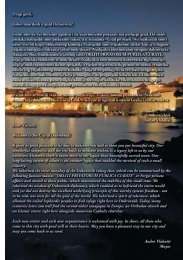24. Welcome to Dubrovnik - TuristiÄka zajednica grada Dubrovnika
24. Welcome to Dubrovnik - TuristiÄka zajednica grada Dubrovnika
24. Welcome to Dubrovnik - TuristiÄka zajednica grada Dubrovnika
You also want an ePaper? Increase the reach of your titles
YUMPU automatically turns print PDFs into web optimized ePapers that Google loves.
Napisao / by Josip Žuvela<br />
Bitter Orange<br />
The sour or bitter orange – as<br />
the people of <strong>Dubrovnik</strong> call<br />
it - has always adorned the<br />
gardens of <strong>Dubrovnik</strong> as an almost<br />
indispensable detail against s<strong>to</strong>ne walls<br />
and gloriettes in the courtyards of<br />
monasteries and summer residences.<br />
Nowadays it welcomes visi<strong>to</strong>rs in the<br />
gardens located at the western and<br />
eastern City gates, particularly in<br />
autumn and winter when the evergreen<br />
branches of the bitter orange trees<br />
become heavy with fruit. The bitter<br />
orange holds an important place in<br />
the his<strong>to</strong>ry and tradition of the City<br />
of <strong>Dubrovnik</strong>. Its fruit, whose colour<br />
ranges from deep orange <strong>to</strong> red,<br />
has always adorned the Franciscan<br />
Monastery gardens, where – according<br />
<strong>to</strong> P. Casole’s travelogue from 1494<br />
– «oranges, pomegranates and other<br />
valuable plants shade the entire<br />
monastery». During holidays and<br />
festivities in <strong>Dubrovnik</strong> the Old City<br />
is traditionally decorated with laurel<br />
wreaths garnished with bitter oranges.<br />
The bitter orange was most probably<br />
brought <strong>to</strong> <strong>Dubrovnik</strong> by seamen<br />
already at the time of the <strong>Dubrovnik</strong><br />
Republic, and in the course of time it<br />
has become an essential tree in every<br />
traditional <strong>Dubrovnik</strong> garden, proudly<br />
attracting attention with its beauty and<br />
fragrance.<br />
The bitter orange came <strong>to</strong> our region<br />
in the 10th century from the Arabian<br />
Peninsula, while the sweet orange<br />
was brought <strong>to</strong> the Mediterranean by<br />
Portuguese seamen from the area of<br />
present-day South China only in the<br />
16th century. Therefore, the bitter<br />
orange came <strong>to</strong> our region very early<br />
on and became naturalized in the then<br />
<strong>Dubrovnik</strong> Republic, having become a<br />
synonym for a beautiful and well kept<br />
garden. By the way, the bitter orange is<br />
a very hardy and long-lived plant.<br />
The name of the fruit often confuses<br />
visi<strong>to</strong>rs and curious people. A bitter<br />
orange? Is that possible? Yes, indeed.<br />
This exceptional plant grows in<br />
<strong>Dubrovnik</strong>. It does look like an ordinary<br />
orange, but it has a specific bitter taste.<br />
Recognised in gastronomy from ancient<br />
times, it also has medical properties. The<br />
bitter orange is literally a true natural<br />
treasure and – as often happens in our<br />
country – it is not sufficiently exploited,<br />
while the utilization of this plant in the<br />
world’s food and cosmetic industry is<br />
considerable.<br />
At the time of the old <strong>Dubrovnik</strong><br />
Republic, already in the 12th century,<br />
the bitter orange was available in the<br />
open-air market, and its juicy fruit and<br />
leaves have continued <strong>to</strong> play a major<br />
role in the gastronomy of the <strong>Dubrovnik</strong><br />
area right up <strong>to</strong> <strong>to</strong>day. Owing <strong>to</strong> its<br />
characteristic scent and taste it was<br />
used as a spice in the culinary art, and<br />
given as a present <strong>to</strong> loved ones and <strong>to</strong><br />
carol singers, whereas in present-day<br />
<strong>Dubrovnik</strong> cuisine one cannot imagine<br />
a fatty Christmas roast without bitter<br />
orange. The <strong>Dubrovnik</strong> bitter orange<br />
and almond gateau is widely known.<br />
World famous alcohol beverages such as<br />
Grand Marnier, Cointreu, Curacao and<br />
Triple sec are made from various parts of<br />
the plant. Bitter orange juice consumed<br />
with tea used <strong>to</strong> soothe colds and flu.<br />
Tea made from bitter orange leaves<br />
calmed the nerves, facilitated digestion<br />
and was used for bathing wounds. In the<br />
words of Ivo Vojnović: “Bitter orange<br />
leaves bes<strong>to</strong>w a peaceful sleep.” Oysters<br />
were served with bitter orange, instead<br />
of lemon. Nowadays the most delicious<br />
and aromatic jam and syrup is made<br />
from bitter orange. Its grated zest is<br />
used for cakes, and one cannot imagine<br />
<strong>Dubrovnik</strong> gelatine without bitter<br />
orange juice. Bitter orange leaves have<br />
always been used for the decoration of<br />
<strong>Dubrovnik</strong>’s local pastries, while freshly<br />
squeezed orange juice was served with a<br />
few drops of ruzolin (rose petal liqueur).<br />
The famous arancini are made from<br />
orange peel.<br />
The bitter orange’s essential oil is used<br />
in the perfume industry, while recipes<br />
for a special bitter orange jam – which<br />
could serve as an original <strong>Dubrovnik</strong><br />
souvenir - have been preserved until<br />
<strong>to</strong>day. It is estimated that nowadays<br />
there are around 2000 bitter orange<br />
trees in the <strong>Dubrovnik</strong> wider area and<br />
that a single tree gives 20 kg of fruit on<br />
average, which amounts <strong>to</strong> 40.000 kg<br />
al<strong>to</strong>gether. The large quantity of this<br />
precious fruit is, unfortunately, not used<br />
sufficiently but – along with a growing<br />
interest in bitter orange fruit processing<br />
for jam, marmalade, arancini and other<br />
products – it could become a major item<br />
in the overall economy of the <strong>Dubrovnik</strong><br />
area, which is compatible with the<br />
image of <strong>Dubrovnik</strong> as a successful and<br />
recognizable <strong>to</strong>urist brand, all the more<br />
so because the fruit does not require<br />
special care.<br />
Winter 2012/13<br />
<strong>Welcome</strong> <strong>to</strong> <strong>Dubrovnik</strong> 55
















